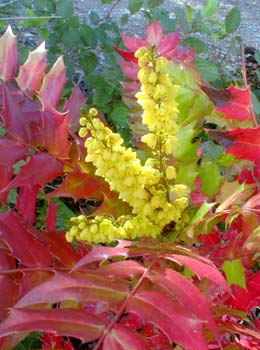
'Charity'
Oregon Grape
"Last year, & the one before,
and the one before that, I longed
for light, for the yellow blossoms
that divine themselves."
-Kate Reavey
A recipient of the Award of Garden Merit in 1957 & of the First Class Certificate in 1962, this is not really an Oregon species despite the usual common name of Oregon grape. Mahonia media (improperly M. intermedia) was the name bestowed by Chris Brickwell upon all intentional & accidental hybrids of two asiatic species of Oregon grape, M. japonica native to Japan & China, & M. lomariifolia native from northwest Yunnan China to northern Burma.Although the hybrid 'Charity' has been recognized since 1957, it was not until the start of the 21st century that it gained wide distribution to American gardens.
It is fertile & can be grown from seed, & may even self-seed, though it does not grow true to the parent. For plants with identical traits it is grown from cuttings taken in autumn & winter, started from the year's new growth.
In the coastal northwest this hybrid mahonia does best in moist well-drained soil in full sun to brightest shade, & can even tolerate some dryness when in partial shade. Inland it likes increasing percentages of shade.
I planted one at the forest edge of an estate for which I did some landscaping, in a location where it had light shade from evergreen trees, but with good afternoon light. With protection part of the day, it was able to thrive outside the boundaries of regular irrigation.
Depending on zone it can bloom anywhere between October & March. Locally it is in full flower mid December, & most certainly the buds are fully open by January. The blossoms have a faint honey scent.
It is an excellent plant for winter gardens because thoroughly evergreen, & it has the brightest yellow racemes of winter flowers that fountain from the top of each extremely erect branch.
It can over time reach ten or even fifteen feet of vase-shaped or columnar height, but it has all of its mature qualities in place at three feet of height. Left to its druthers it will grow quite tall, but if the spent flowers are pinched off in spring, the shrub will develop more branchings & can be pruned to keep it from becoming very tall.
The leaves are holly-like but gigantic, arranged in spectacular rosettes. These can be very colorful in zones where they experience a sufficient winter chill to turn intensely fiery red, holding this color until the very end of winter. The January portrait above captures it at its winter reddest, along with yellow flowers. But if autumns & winters are too mild it may remain dark green.
To produce maximum fruits it needs cross-pollinizing with other mahonias, & it appears that the Northwest species will do the job just so long as the flowers blooming time overlap.